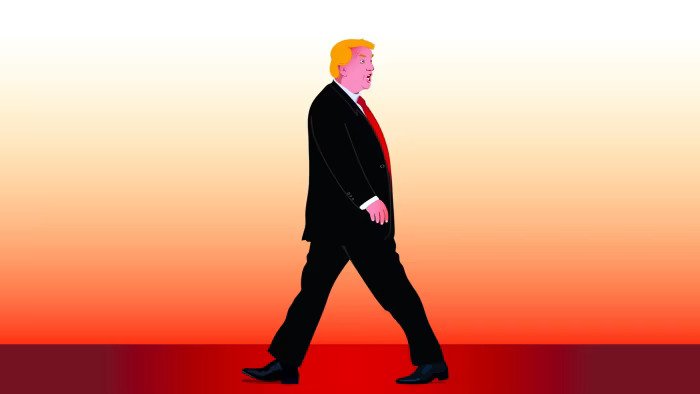Trump’s Erratic Moves Fuel Market Confusion
“There are many reasons to feel confused by current American policy,” the Financial Times begins. President Donald Trump keeps issuing “final” tariff threats — then backing down. The White House claims it wants to create industrial jobs but is simultaneously gutting the Inflation Reduction Act, which was already doing that — “mostly in red states.”
Scott Bessent, Treasury secretary, says he wants dollar dominance, yet the dollar has fallen 10 percent. And while markets should be giving some direction, they’re sending conflicting signals too.
Bonds Point to Slowdown, Stocks See Growth
“If you want to feel more baffled, look at markets,” the article continues. This month, the one-year swaps market is pricing in modest rate cuts from the Federal Reserve — a signal of lower growth and inflation.
But then you look at equities: American stock markets are “at record highs” and analysts on Wall Street are predicting strong earnings and continued gains. Cyclical stocks — those that benefit from growth — are even “significantly outperforming” defensive ones, says Torsten Sløk, chief economist at Apollo.
“This is not consistent,” Sløk adds. “Either the bond market is wrong, and rates must move higher due to accelerating growth. Or, equity markets are wrong, and stocks have to move lower because growth is slowing down.”
The “Double Taco” and “Double Genius” Theories
The FT offers three possible explanations for this dissonance. One of them is the “double Taco” trade, based on the idea that “Trump always chickens out.” Equity markets might be assuming that tariff threats will be watered down, while bond markets believe Trump won’t actually follow through on debt-expanding policies that would scare off investors.
“This is not crazy.” Trump has walked back tariffs several times this year. He’s also dropped threats to fire Jay Powell and removed a Section 899 clause that could’ve spooked non-American Treasury buyers. That clause was omitted from Trump’s “big, beautiful bill,” which became law just last week.
Then there’s the more optimistic “double genius” idea: “investors believe that Trump will actually execute his plans, but they will be so brilliant that they deliver higher growth, lower prices and falling debt — all at once.”
Trump’s economic adviser Kevin Hassett claims the BBB act will “turbocharge growth,” while deregulation and cheaper energy will tame inflation. When Moody’s downgraded the U.S. credit rating due to the $37 trillion debt, Bessent dismissed it as a “lagging indicator,” saying revenues will increase because of tariffs and economic expansion.
Fiscal Tricks and Market Calm
To manage the $9 trillion in Treasury auctions coming in the next year, Bessent is rolling out “tricks” to encourage bond buying. These include pushing banks to purchase more bonds and favoring short-term over long-term issuance — ironic, given that Bessent criticized Janet Yellen for doing just that.
Some investors seem to buy into this narrative. The Atlanta Fed’s real-time GDP tracker shows 2.6 percent growth. Tariffs haven’t yet driven prices significantly higher. Even though the World Bank has downgraded global growth forecasts, Oxford Economics suggests that the new tariffs and the 50 percent copper levy present “only modest downside risk.”
They estimate these moves will add just 0.08 percentage points to core inflation next year and shave off only 0.1 percent of real GDP — which the BBB’s fiscal boost could offset. Even with an effective U.S. tariff rate nearing 20 percent by August 1, Oxford notes that’s “less than our recession threshold.” Hence, “market calm.”
The Real Problem: No Precedent, No Predictability
The FT closes with a more cynical explanation: “it is simply impossible to make credible — or consistent — forecasts now due to a lack of recent historical precedents for Trump, and pernicious time-lag effects.”
Companies have built massive stockpiles to avoid tariffs. Supply chains are shifting — “easy in some sectors (like T-shirts),” but “hard in others (like laptops and fireworks).” Immigration curbs could reduce growth by 0.75 to 1 percentage points, per the Dallas Fed, but “the timing of this is unclear.” So is the impact of Trump’s proposed spending cuts, most of which won’t hit until after the 2026 midterms.
What’s more, Trump’s unpredictable flip-flops may prompt companies to delay investments — or, as during the pandemic, simply adapt to the chaos.
“Maybe more clarity will emerge when American companies report on earnings next week. Or maybe either the bond or equity markets will adjust. Until then, however, they symbolise the confusion. Think of this when you next look at your portfolio.”
Source:
Financial Times, “Trump is sowing confusion in the markets”
